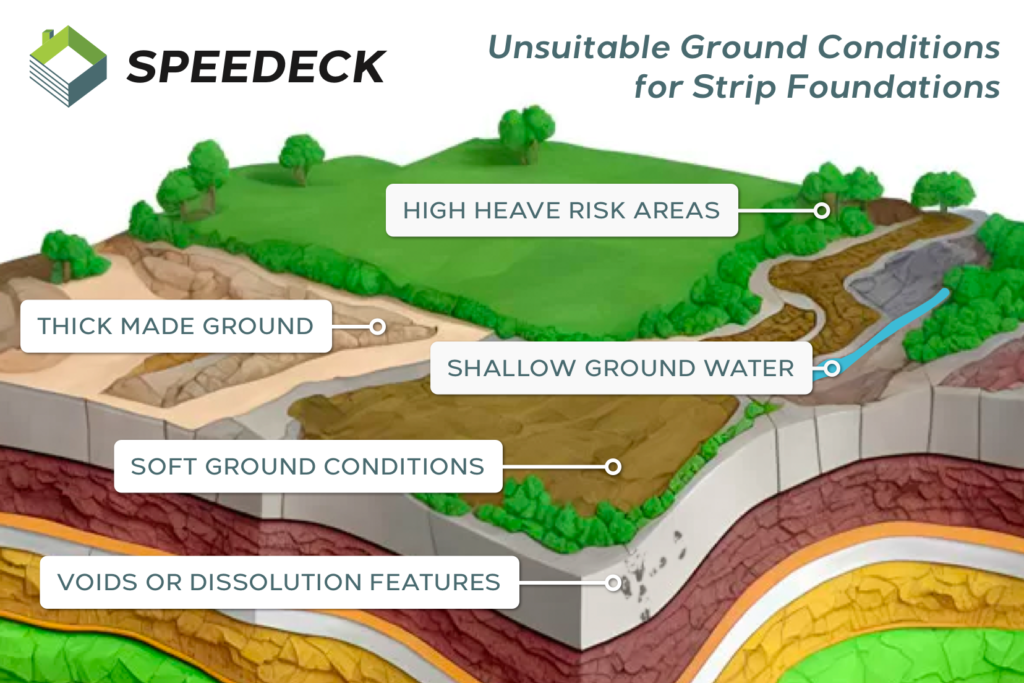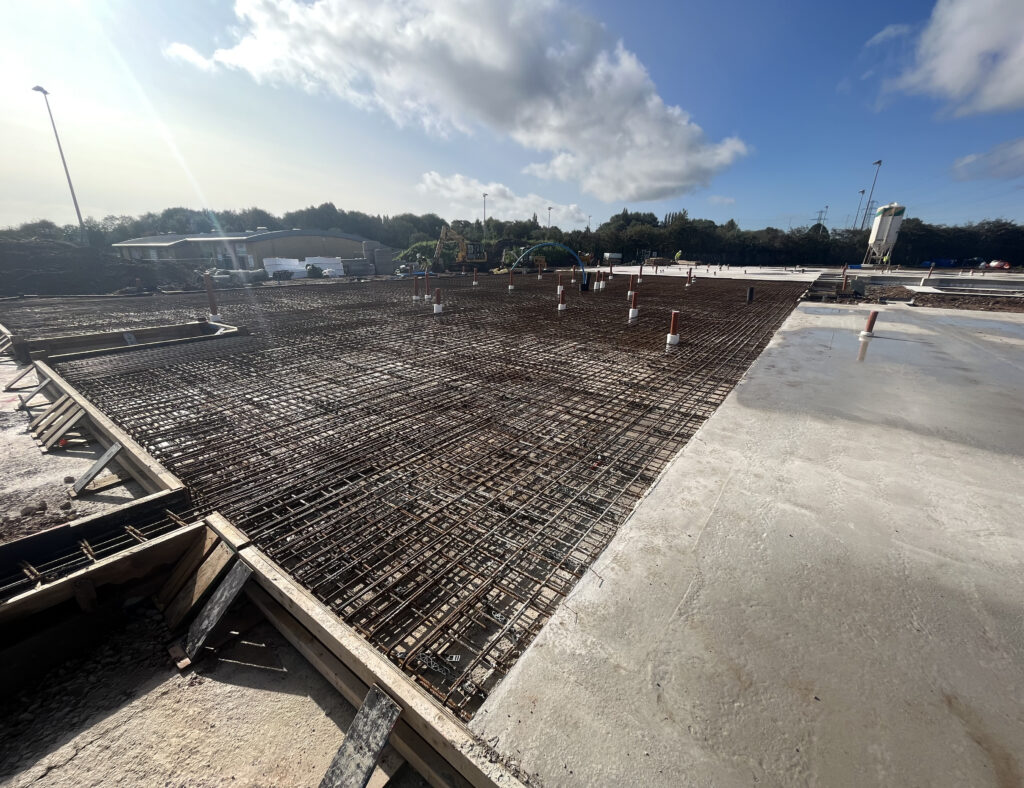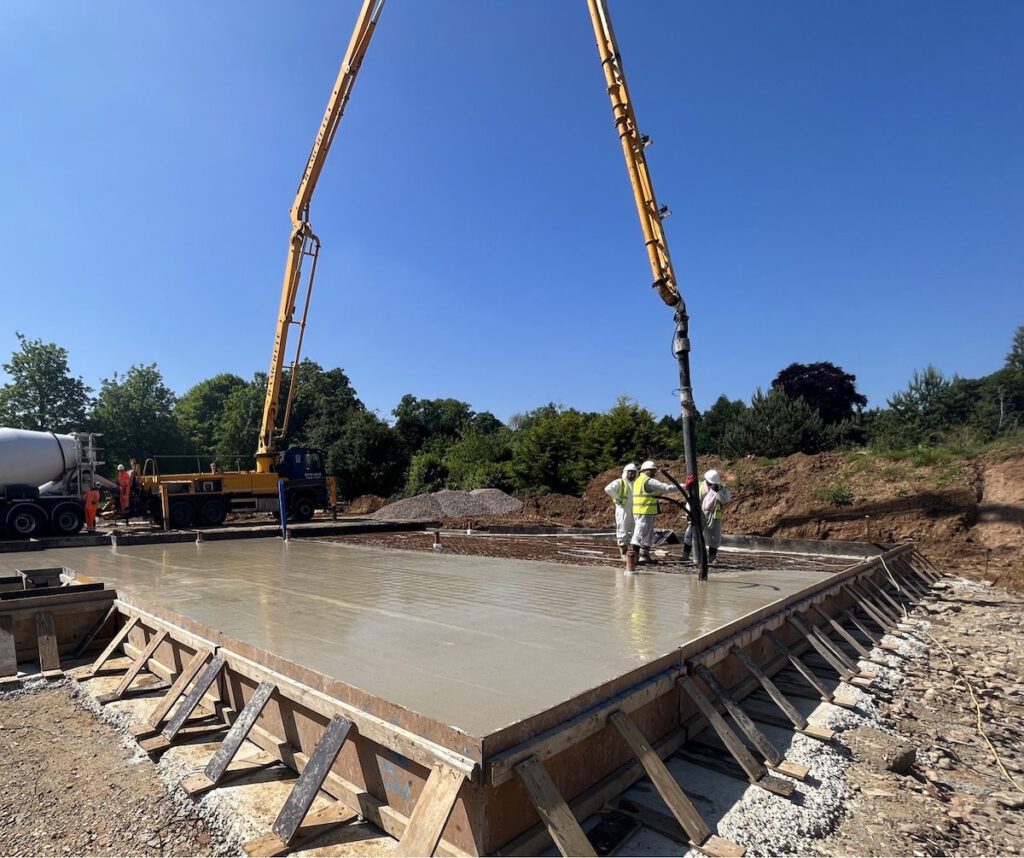Whilst Strip Foundations are beneficial in specific circumstances, not all terrains allow for their straightforward application. Certain ground conditions can provide economic opportunities for developers and architects, potentially shifting the scales towards alternative methods for low rise developments foundation schemes.
In this article we’ll be exploring the benefits, challenges and ground conditions in which alternatives to strip foundations may be a better solution for housing developments.
Understanding Strip Foundations
Strip foundations consist of a shallow trench cut into the ground and filled with concrete, on which the building structure can be supported. They are most suited to soils that have a strong bearing capacity and do not exhibit significant swelling or shrinkage properties, which could otherwise lead to structural instability.

Strip Foundations being prepared
Strip foundations can be designed to accommodate different load requirements by varying the width and depth of the foundation strip, and can be constructed to be level or stepped, depending on the slope of the site and the specific design requirements of the building.
The simplicity and cost-effectiveness of strip foundations make them a popular choice for new residential developments in the UK.
Challenges with Strip Foundations
Despite being commonly used, Strip foundations come with their own set of challenges, especially when ground conditions are not ideal, and the decision to use strip foundations must be based on a comprehensive evaluation of ground conditions across the site.
This evaluation would include assessing the load-bearing capacity, identifying areas with weaker soil, and considering external factors like access or water flows that might affect the foundation. Failure to accurately assess these conditions can lead to unexpected complications and costs, diminishing the cost-effectiveness of using strip foundations.

Certain site conditions significantly challenge the feasibility of strip foundations, compelling the consideration of alternative solutions. These conditions include:
Areas Where Heave Risk is Present
Heave, characterised by the upward movement of soil, especially expansive clays, can severely impact the depth and design of strip foundations. The rehydration of these soils, often following the removal of vegetation, leads to expansion that can exert undue pressure on foundations.
If heave risk is present, strip foundations need to be taken deeper, to below the depth affected by heave. Once this depth becomes more than 1.5m, the costs associated with strip foundations start to become markedly higher and alternative options become more economical. In addition, the use of heave protection on the sides of the strip foundations adds further construction cost.
Areas of Thick Made Ground
Made Ground, a surface layer of man-made soils and materials, is not generally acceptable as a bearing stratum for foundations. Its variability in both composition and compaction can lead to uneven bearing capacity and differential settlement.
Strip foundations need to be taken down to competent natural strata beneath the Made Ground. Again, once this depth becomes more than 1.5m, alternative options are likely to be more cost-effective.
Soft Ground Conditions
Soft ground conditions, marked by their low bearing capacity and high compressibility, call for more robust foundation approaches.
The presence of very soft or unstable ground requires strip foundations to be dug deeper, to a depth at which a competent founding stratum is found, making the foundations more expensive. In addition, the presence of the soft material can complicate the construction of strip foundations as shoring may be required to keep the trench sides stable, adding further time and cost to the construction.
Shallow Groundwater
The presence of shallow groundwater complicates strip foundation construction by adding practical problems when the excavation for the strips is below the groundwater level. Issues with maintaining the stability of the trenches and dewatering can cause site delays and add cost to the construction. Foundation options that require no excavation below groundwater level are always likely to be a more sensible solution in such cases.
Presence of Dissolution Features or Voids

Subsidence effects on a house
Dissolution features or voids in the subsoil pose a significant hazard to strip foundations. Bearing capacity may be unreliable and unexpected voids could lead to differential settlement and/or significant structural damage. Strip foundations can be reinforced to resist some of these effects, however the cost this adds to the construction will make other foundations solutions a better choice.
Economical Alternatives to Strip Foundations
Each of the above specific conditions underscore the critical need for a nuanced understanding of site-specific geotechnical challenges. If strip foundations need to be deeper than 1.5m, alternatives such as piled foundations and raft foundations may offer economic advantages.
Early identification and strategic planning can guide the selection of the most appropriate foundation and leverage innovative engineering solutions to mitigate challenges in the ground effectively.
Piled Foundations
Piled foundations present a reliable alternative to traditional strip foundations in challenging ground conditions, such as those with soft soil, high water tables, or where load-bearing strata are deep underground.
Piled foundations involve driving or drilling piles deep into the ground to reach stable soil layers, offering a solid base for structures where surface conditions are not supportive enough for conventional foundations.

SPEEDECK Piling in Progress
Piled foundations are essential for projects located in areas prone to ground movement, such as expansive clays or reclaimed lands. They are also pivotal in urban environments where existing underground services or adjacent structures limit excavation depths for strip foundations.
Raft Foundations
Unlike Strip Foundations, where the loads from the building are primarily carried by the walls, Raft Foundations are a large slab, distributing loads from the structure evenly across the surface of the foundation.
Raft Foundations are particularly suitable for certain types of poorer soils, softer ground, shallow groundwater or areas with dissolution features. Raft Foundations may offer a cost-effective solution where the excavation costs for deeper foundations such as piles would be prohibitive.
Ground Improvement
Various ground improvement methods that either compact or stiffen the shallow soil mass to allow the use of shallow foundations such as strips, pads or rafts may be an appropriate benefit. This option is particularly effective for addressing soft ground and/or ensuring excavations do not need to take place below the groundwater table.
SPEEDECK Piled Raft
SPEEDECK’s Piled Raft solution combines the deep foundation support of piling with the load distribution efficiency of a raft foundation.
This provides robust support in the most challenging ground conditions, and compared to traditional pile and beam solutions offers significant cost savings thanks to the elimination of other follow-on trades.

SPEEDECK’s methodology optimises pile type, lengths and diameters to enhance structural support while achieving significant material and time efficiencies.
SPEEDECK’s Approach to Foundation Solutions
SPEEDECK’s tailored approach ensures that each project benefits from the most optimally viable foundation, balancing initial costs with the prevention of future issues and sustainability requirements.
Each project begins with a comprehensive evaluation of site conditions, leveraging advanced geotechnical assessments to understand soil types, bearing capacities, and potential hazards.
Our team then determines the most economical and environmentally sustainable foundation strategy. While our piled raft often provides the most cost-effective solution in many of the above circumstances, we do consider all alternatives, and will always suggest the most appropriate foundation. Where strip foundations are viable, we will still advise so.
With an emphasis on collaboration and communication throughout, SPEEDECK works closely with all project stakeholders to ensure strategies are aligned and challenges are addressed with appropriate engineering solutions that not only ensure structural integrity but also foster successful project execution.
Conclusion
The critical importance of selecting the right foundation type in housebuilding cannot be overstated. Ground conditions play a pivotal role in this decision-making process, dictating the need for either traditional strip foundations or exploring alternative solutions like piling and raft foundations.

Pre-construction review of foundation scheme
SPEEDECK’s commitment to providing economical and tailored foundation solutions shines when presented with challenges posed by diverse site conditions. Our focus on engineering excellence and sustainability ensures projects meet structural requirements, which consider the economic and environmental impacts, guaranteeing longevity and stability.
Are you facing foundation challenges on your construction site? SPEEDECK is here to offer expert assessments and innovative solutions tailored to your site’s specific needs.
Our team of specialists is equipped to navigate the challenges in the ground, delivering foundation strategies that contribute to the overall success of your project.
Contact SPEEDECK today to take the first step towards an engineered foundation for your unique development.






